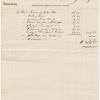Letter from Robert Hanley Hall to Edward Burnett Tylor, 15 November 1900
Commentary
Letter sent from Victoria by Robert Hanley Hall of the Hudson’s Bay Company to Professor Edward Burnett Tylor in Oxford, dated 15 November 1900.
Transcript of letter (2 pages): ‘Dear Sir,/ I duly received your letter of the 24th July, and now write to say that I have at last shipped your Totem Pole. I have held it for a long time, hoping to be able to ship it at a low rate by sailing vessel, but in this I have been disappointed./ I found that the C. P. R. [Canadian Pacific Railway] rates were within a few dollars as economical as those by sailing vessel, and, as there is much greater safety in sending the Totem by rail to the Atlantic Seaboard and thence by Steamer to England, than in shipping it on a six months’ voyage around the Horn, I have sent it over the Canadian Pacific Railway. The Totem (cut in 2 pieces) has been well crated, and the Agent of the C. P. R. has promised that it will have extra care en route./ A similar Totem Pole has been erected in a public square in the City of Seattle, Washington, and attracts a great deal of attention. I observed carefully how it was erected, and by my observations may possibly be of some assistance to you. The Totems, as erected by the Indians, are scooped out,// thus, [sketch of a hollowed, concave log][.] I suppose this is to make them lighter and easier to handle where they have none of the white man’s appliances, such as derricks, blocks and tackles, etc. At Seattle they have again cut out the Totem, thus [sketch of a log with a triangular wedge removed] and have fitted in the back of it a spar of timber, which completes the circle and gives strength and stability to the erected Totem./ After its erection they repainted it and, although their Totem is a very old one, it now has the appearance of being quite new. Putty has been largely used in the cracks, and new wood has been dovetailed in and rotten spots cut out./ Totem Poles will soon cease to exist, as none are now made, the Indians having abandoned their ancient customs, and the present generation having lost the cunning of their fathers./ I enclose shipping bill and Bill of Lading of the Totem, also Account for $154.00, which covers the price paid to the Indians for it and all transportation charges to this point. I shall be glad if you will send exchange for this amount direct to me./ Hoping the Totem will reach you safely and in good order,/ I remain,/ Yours faithfully,/ [signed:] R. H. Hall.’ (Transcription by Philip Grover.)
***
Exhibition label: ‘The earliest throughts of bringing a totem pole to Oxford came in 1897, when Edward Burnett Tylor, Keeper of the University Museum, saw the celebrated example which had been erected in the grounds of Foxwarren, in Surrey, brought to England from Canada some years earlier. The evidence shows that from this time Tylor made considerable efforts to acquire a similar item for the University, noting that ‘there is a place in this Museum exactly suited to a fine pole of 40 ft or even more, and I am much set on getting one.’ The three letters displayed here on the left are drawn from the Museum’s original documentation relating to the purchase of the totem pole, which was negotiated and arranged by Robert Hanley Hall of the Hudson’s Bay Company. Prof. E. B. Tylor himself paid a price of $36 for the pole, and a further $118 for sundries including repairs and cleaning; afterwards it was transported by boat from Masset to Victoria, and thereafter by rail and sea to England.’ Source: ‘Star House Pole: Early Images of the Haida Totem Pole in the Pitt Rivers Museum’, exhibition curated by Philip Grover, Pitt Rivers Museum, University of Oxford, 9 June to 28 September 2014.

